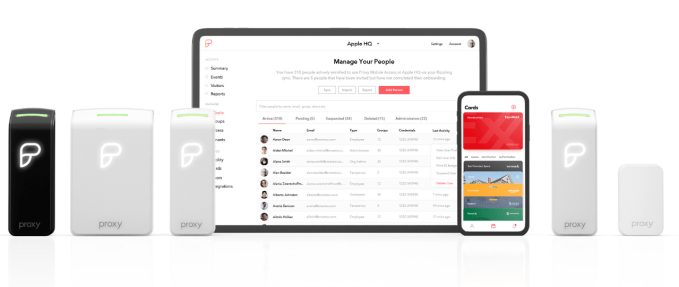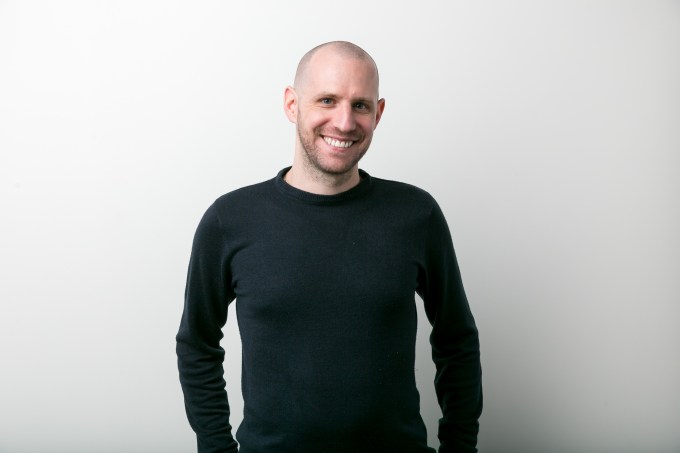Recent Funding
Auto Added by WPeMatico
Auto Added by WPeMatico
Kimberly Shenk has been focused for a while now on “clean” products that are made without harmful chemicals. In 2017, Shenk and friend Jaleh Bisharat launched NakedPoppy, a site that curates and sells cosmetics that have been vetted by chemists (including some of its own products).
Interestingly, as the young startup was announcing $4 million in seed funding last summer from Cowboy Ventures, among others, Shenk — who remains on the board of Naked Poppy — was splitting off to launch a second company. Called Novi, it hopes to address the same need that Shenk and Bisharat discovered, but it plans to go much broader.
Specifically, Novi is developing a platform that it hopes will eventually become a go-to service for beauty brands, as well as a lot of other businesses that sell to the growing number of consumers concerned about what, exactly, is in their homes. Think carpet sellers, medical device makers, developers of house cleaning products like detergents. If it needs to be formulated, Novi wants to assess it and give it its stamp of approval.
It’s not an easy thing to pull together, concedes Shenk, a graduate of the United States Air Force Academy and MIT who spent several years as the head of Eventbrite’s data science operation. Just one of the many steps involved is building connections to far-flung and disparate raw suppliers, like makers of the surfactants used for cleansing, foaming, thickening and other special effects in cosmetics. The reason: Novi will need to learn about and certify as safe their manufacturing processes.
It’s a major piece of the overall puzzle, and it’s harder than it might sound to nail down, as many manufacturers are hesitant to share information that they view as proprietary.
Still, Novi thinks it can persuade them to be more forthcoming by touting an AI-driven platform that it says can ingest and manage manufacturers’ proprietary data at scale — and make it easier, in turn, for consumer companies that are focused on using vetted ingredients and chemicals to find them. Indeed, where Novi will really shine, suggests Shenk, is in data management.
Investors who know her seem to think she has what it takes. Brian Rothenberg, a partner at Defy Partners who helped scale Eventbrite across six years before he joined the world of venture capital, just led a $1.5 million seed round for Novi. (“We see a groundswell of consumer consciousness in this area,” Rothenberg said in an emailed statement to us.)
The startup further has the backing of Eventbrite co-founders Kevin and Julia Hartz.
Also working in its favor: Novi says it’s already working with a large beauty retailer that likes the results it has seen as a customer of Novi’s software-as-a-service. (Shenk declines to name the outfit, but she says another reason she had to split off from NakedPoppy was the high likelihood that Novi would be working with competitors to the company.)
It’s certainly progress, considering that Novi is still fairly nascent, with a team of just four people as it ramps up.
In addition to Shenk, it’s run by Bisharat, who remains CEO of NakedPoppy but is also a co-founder of Novi and a board member; an engineer; and a chemist who previously worked for another “clean” beauty company, called Beautycounter.
Powered by WPeMatico
Quit Genius, the YC-backed startup that uses cognitive behavioral therapy to help folks quit smoking and vaping tobacco products, has today announced the close of an $11 million Series A round.
The new funding was led by Octopus Ventures, with participation from Y Combinator, Startup Health and Triple Point Ventures.
Quit Genius was built by doctors — Yusuf Sherwani (co-founder and CEO), Maroof Ahmed (co-founder and COO) and Sarim Siddiqui (co-founder and head of product) — who met on the first day of medical school. They saw the terrible effects of smoking on patients’ health but didn’t see doctors giving those patients a clear path to quit smoking.
Cognitive behavioral therapy is seen as one of the more effective treatments for breaking addiction, helping patients focus on their thoughts, feelings and behaviors and understanding how one affects the others. The Quit Genius app helps users recognize when a negative thought or feeling pops up, and replace those triggering thoughts and emotions with more positive, healthier thoughts. This is done through various types of content, such as audio sessions, animated videos and interactive exercises.
The company also offers a device that can pair with the app to test users’ breath and help hold them accountable to their goal of quitting.
Quit Genius has already made headway with its smoking and vaping products, and is going to use the funding to expand into other types of addiction, such as alcohol and opioid addiction.
Alongside its consumer-facing product, Quit Genius also offers an enterprise product to businesses that are looking to foster a healthy workforce and also save money on healthcare for employees. Unlike most enterprise wellness programs that charge per person per year (regardless of utilization or engagement), Quit Genius only charges by engagement (employees who use the program) and offers a 25% quit rate guarantee.
In other words, if 25% of enrolled users don’t achieve their goal of quitting, Quit Genius will partially refund fees. Thus far, the company hasn’t had to do that, reports CEO Sherwani.
Sherwani added that the company has signed up 15 enterprise clients, split between self-insured employers and health plan providers.
Beyond the funding and expansion into other forms of addiction, Quit Genius is also trying to do its own part as the novel coronavirus pandemic spreads across the globe. Noting the high-risk status of smokers, Sherwani said that the company will offer its product for free to new sign-ups through April so that they can quit smoking immediately.
Founded by doctors, Quit Genius prioritizes efficacy. The company has enlisted independent research studies to show the success rate of its product, the results of which have been published in peer-reviewed journals. According to that research, more than 60,000 people have quit smoking, with a 53% quit rate, which is higher than other quit-smoking techniques.
The startup has raised a total of $13.6 million from investors listed above, as well as Eric Ries, Serena Williams’ Serena Ventures, Venus Williams and Instacart co-founder Max Mullen.
Powered by WPeMatico
You have to actually get work done, not just video call all day, but apps like Zoom want to take over your screen. Remote workers who need to stay in touch while staying productive are forced to juggle tabs. Meanwhile, call participants often look and sound far away, dwarfed by their background and drowned in noise.
Today, Around launches its new video chat software that crops participants down to just circles that float on your screen so you have space for other apps. Designed for laptops, Around uses auto-zoom and noise cancelling to keep your face and voice in focus. Instead of crowding around one computer or piling into a big-screen conference room, up to 15 people can call from their own laptop without echo — even from right next to each other.

“Traditional videoconferencing tries to maximize visual presence. But too much presence gets in the way of your work,” says Around CEO Dominik Zane. “People want to make eye contact. They want to connect. But they also want to get stuff done. Around treats video as the means to an end, not the end in itself.”
Around becomes available today by request in invite-only beta for Mac, windows, Linux, and web. It’s been in private beta since last summer, but now users can sign up here for early access to Around. The freemium model means anyone can slide the app into their stack without paying at first.

After two years in stealth, Around’s 12-person distributed team reveals that it’s raised $5.2 million in seed funding over multiple rounds from Floodgate, Initialized Capital, Credo Ventures, AngelList’s Naval Ravikant, Product Hunt’s Ryan Hoover, Crashlytics’ Jeff Seibert, and angel Tommy Leep. The plan is to invest in talent and infrastructure to keep video calls snappy.

Around CEO Dominik Zane
Around was born out of frustration with remote work collaboration. Zane and fellow Around co-founder Pavel Serbajlo had built mobile marketing company M.dot that was acquired by GoDaddy by using a fully distributed team. But they discovered that Zoom was “built around decades-old assumptions of what a video call should be” says Zane. “A Zoom video call is basically a telephone connected to a video camera. In terms of design, it’s not much different from the original Picturephone demoed at the 1964 World’s Fair.”
So together, they started Around as a video chat app that slips into the background rather than dominating the foreground. “We stripped out every unnecessary pixel by building a real-time panning and zooming technology that automatically keeps callers’ faces–and only their faces–in view at all times” Zane explains. It’s basically Facebook Messenger’s old Chat Heads design, but for the desktop enterprise.
Calls start with a shared link or /Around Slack command. You’re never unexpectedly dumped into a call, so you can stay on task. Since participants are closely cropped to their faces and not blown up full screen, they don’t have to worry about cleaning their workspace or exactly how their hair looks. That reduces the divide between work-from-homers and those in the office.
As for technology, Around’s “EchoTerminator” uses ultrasonic audio to detect nearby laptops and synchronization to eliminate those strange feedback sounds. Around also employs artificial intelligence and the fast CPUs of modern laptops to suppress noise like sirens, dog barks, washing machines, or screaming children. A browser version means you don’t have to wait for people to download anything, and visual emotes like “Cool idea” pop up below people’s faces so they don’t have to interrupt the speaker.

Traditional video chat vs Around
“Around is what you get when you rethink video chat for a 21st-century audience, with 21st-century technology,” says Initialized co-founder and general partner Garry Tan. “Around has cracked an incredibly difficult problem, integrating video into the way people actually work today. It makes other video-call products feel clumsy by comparison.”
There’s one big thing missing from Around: mobile. Since it’s meant for multitasking, it’s desktop/laptop only. But that orthodoxy ignores the fact that a team member on the go might still want to chime in on chats, even with just audio. Mobile apps are on the roadmap, though, with plans to allow direct dial-in and live transitioning from laptop to mobile. The 15-participant limit also prevents Around from working for all-hands meetings.
Competing with video calling giant Zoom will be a serious challenge. Nearly a decade of perfecting its technology gives Zoom super low latency so people don’t talk over each other. Around will have to hope that its smaller windows let it keep delays down. There’s also other multitask video apps like Loom’s asynchronously-recorded video clips that prevent distraction.
With coronavirus putting a new emphasis on video technology for tons of companies, finding great engineers could be difficult. “Talent is scarce, and good video is hard tech. Video products are on the rise. Google and large companies snag all the talent, plus they have the ability and scale to train audio-video professionals at universities in northern Europe” Zane tells me. “Talent wars are the biggest risk and obstacle for all real-time video companies.”
But that rise also means there are tons of people fed up with having to stop work to video chat, kids and pets wandering into their calls, and constantly yelling at co-workers to “mute your damn mic!” If ever there was a perfect time to launch Around, it’s now.

“Eight years ago we were a team of locals and immigrants, traveling frequently, moving between locations and offices” Zane recalls. “We realized that this was the future of work and it’s going to be one of the most significant transformations of modern society over the next 30 years . . . We’re building the product we’ve wanted for ourselves.”
One of the best things about working remotely is you don’t have colleagues randomly bugging you about superfluous nonsense. But the heaviness of traditional video chat swings things too far in the other direction. You’re isolated unless you want to make a big deal out of scheduling a call. We need presence and connection, but also the space to remain in flow. We don’t want to be away or on top of each other. We want to be around.
Powered by WPeMatico
Smart rings are still a relatively young category in the wearable hardware world, but the Oura Ring seems to be a standout in terms of early success. The Oura Ring hardware is sleek and packed with sensors, allowing it to measure a user’s sleep patterns, take your body temperature and track activity, and now Oura has raised $28 million in Series B funding to bring on new key hires and product updates.
In a Medium post announcing the raise, Oura CEO Harpreet Singh Rai revealed that to date, the company has sold over 150,000 of its rings since launch (which was in early 2018) and that its team has grown to over 100 people globally. The Series B funding comes from Forerunner Ventures, which has a strong track record when it comes to direct-to-consumer product company investments, as well as from Gradient Ventures and Square.
Along with the investment, Oura gains two new board members, and one new board observer all with expertise in different aspects of the startup’s business: Forerunner’s Eurie Kim and Square’s hardware lead Jesse Dorogusker are the new board members, and Gradient partner (and former VP of engineering at Google) Anna Patterson joins as the observer.
Oura will be revamping its website and adding a new web-based portal for Oura Ring users that offers “actionable insights,” the company says, and it’s going to be doing more in terms of collaborating with academic researchers on ensuring its products measurements and guidance remain as accurate and useful as possible.
Oura prioritizes the role of sleep in terms of its contribution to health, and has also recently ventured into the realm of meditation, but it acts as a general fitness tracking device as well. It has attracted a number of fans among the plugged-in tech elite, too, including Twitter and Square CEO Jack Dorsey. The company deserves kudos for delivering a solid, attractive and feature-rich gadget in a category that seemed like a tough sell in the early offing, and this new funding is a good vote of confidence.
Powered by WPeMatico
Addapptation, a startup that wants to build a practical design layer on top of Salesforce and other enterprise tools, announced a $1.3 million seed investment today.
2048 Ventures led the round with participation from East Coast Angels, The Millworks II Fund and additional angel investors from New Hampshire, where the firm is located
Co-founder Sumner Vanderhoof says the startup’s goal is to build a user experience platform for enterprise tools like Salesforce . “Our goal is to help make simple, easy to use Salesforce.com solutions built on the addapptation UX platform.
“At the end of the day, we’re really helping transform the way companies work, making their employees more efficient, making the job they do easier and more consistent, so they have a bigger impact on the companies that they work for,” Vanderhoof told TechCrunch.
He says they do this by looking at the company workflow and what issue the customer is trying to solve — such as a problem converting deals through the sales cycle. They will then help build tools and an interface to make it easier to pinpoint this information with the goal of being able to reuse whatever solutions they create for other customers.
He says the platform is template-driven and designed to quickly go from idea to solution. A typical solution takes no longer than two weeks to build and implement. Once a customer is using addapptation, employees can log into the addapptation platform or it can be a layer built into Salesforce providing a more guided experience.
The company has built around 40 plug-ins for the platform, including a heat map that identifies where sales is likely to find the best opportunities to close a deal. The solutions they build are designed to work online or on mobile devices as needed.

Photo: addapptation
Vanderhoof says that the company has a good relationship with Salesforce, and it doesn’t compete directly with the company. “Their main focus is providing tools for a wide audience. Ours is extending the platform beyond what it can do,” he said.
The two founders, Vanderhoof and his wife Carla, took three years building the platform, essentially bootstrapping before taking today’s funding. The company has 15 employees in its Exeter, NH, headquarters and has 20 customers including Comcast and Ingram Micro.
Powered by WPeMatico
The rise of the cloud over the past decade has forced software developers and DevOps engineers to completely rearchitect the modern web application, ensuring scalability, performance, and security. That’s a really painful proposition when done manually, which is where Hashicorp comes in to play. The company’s suite of products helps everyone in the tech workforce from IT admins to software developers operate in the cloud (mostly) effortlessly and natively.
The company’s products have long garnered rave reviews from technical staffs, and now the company is looking at a brand new massive valuation.
The SF-based startup announced today that it has raised $175 million in Series E financing from Franklin Templeton Investments at a scorching $5.1 billion valuation. For context, when we last covered the company back in late 2018, its valuation was only a “paltry” $1.9 billion following a $100 million round led by growth investor IVP.
The company in its release today touted its success in doubling revenues and customers every year for four straight years as the key reason behind the flush valuation. The company is making a (not so) subtle point that David McJannet, who joined the company as CEO in mid-2016 following a stint as an EIR at Greylock, has seen some success in his new role.

Hashicorp CEO David McJannet. Photo via Hashicorp
The company, founded by Mitchell Hashimoto and Armon Dadgar in 2012, is one of the major pioneers in helping companies build high-quality infrastructure that’s a mix of multi-cloud providers, private cloud, and even legacy systems.
It’s most well-known product is Terraform, which allows developers to write repeatable rules around enterprise infrastructure rather than a patchwork of different scripts that might not work as its writers intended. The idea is that with a consistent framework, Hashicorp’s product can help companies reduce costs (by protecting against, say, over-provisioning of resources) while also helping to balance scale and performance. The company’s other products include Consul around network automation, Vault for security, and Nomad for application deployment.
Hashicorp touches on a bunch of competitive products, but its cohesive set of tools and strong outreach to the developer community has set itself apart from the competition in recent years.
Franklin Templeton is a fairly late stage investor that has funded such enterprise companies as Cloudflare, which went public last year, logs management platform SumoLogic, and cybersecurity business Tanium, all according to Crunchbase.
With a hefty $5.1 billion valuation, the company narrowly missed the catastrophic decline of SaaS stocks over the past few weeks, which have been buffeted by the rapidly spreading global pandemic. But with a new war chest and a focus on a popular and growing enterprise market, the company seems poised to continue its growth.
Powered by WPeMatico
We need to go hands-off in the age of coronavirus. That means touching fewer doors, elevators, and sign-in iPads. But once a building is using phone-based identity for security, there’s opportunities to speed up access to WIFI networks and printers, or personalize conference rooms and video call set-ups. Keyless office entry startup Proxy wants to deliver all of this while keeping your phone in your pocket.
“The door is just a starting point” Proxy co-founder and CEO Denis Mars tells me. “We’re . . . empowering a movement to take back control of our privacy, our sense of self, our humanity, our individuality.”

With the contagion concerns and security risks of people rubbing dirty, cloneable, stealable key cards against their office doors, investors see big potential in Proxy. Today it’s announcing here a $42 million Series B led by Scale Venture Partners with participation from former funders Kleiner Perkins and Y Combinator plus new additions Silicon Valley Bank and West Ventures.
The raise brings Proxy to $58.8 million in funding so it can staff up at offices across the world and speed up deployments of its door sensor hardware and access control software. “We’re spread thin” says Mars. “Part of this funding is to try to grow up as quickly as possible and not grow for growth sake. We’re making sure we’re secure, meeting all the privacy requirements.”
How does Proxy work? Employers get their staff to install an app that knows their identity within the company, including when and where they’re allowed entry. Buildings install Proxy’s signal readers, which can either integrate with existing access control software or the startup’s own management dashboard.
Employees can then open doors, elevators, turnstiles, and garages with a Bluetooth low-energy signal without having to even take their phone out. Bosses can also opt to require a facial scan or fingerprint or a wave of the phone near the sensor. Existing keycards and fobs still work with Proxy’s Pro readers. Proxy costs about $300 to $350 per reader, plus installation and a $30 per month per reader subscription to its management software.

Now the company is expanding access to devices once you’re already in the building thanks to its SDK and APIs. Wifi router-makers are starting to pre-provision their hardware to automatically connect the phones of employees or temporarily allow registered guests with Proxy installed — no need for passwords written on whiteboards. Its new Nano sensors can also be hooked up to printers and vending machines to verify access or charge expense accounts. And food delivery companies can add the Proxy SDK so couriers can be granted the momentary ability to open doors when they arrive with lunch.
Rather than just indiscriminately beaming your identity out into the world, Proxy uses tokenized credentials so only its sensors know who you are. Users have to approve of new networks’ ability to read their tokens, Proxy has SOC-2 security audit certification, and complies with GDPR. “We feel very strongly about where the biometrics are stored . . . they should stay on your phone” says Mars.
Yet despite integrating with the technology for two-factor entry unlocks, Mars says “We’re not big fans of facial recognition. You don’t want every random company having your face in their database. The face becomes the password you were supposed to change every 30 days.”

Keeping your data and identity safe as we see an explosion of Internet Of Things devices was actually the impetus for starting Proxy. Mars had sold his teleconferencing startup Bitplay to Jive Software where he met his eventually co-founder Simon Ratner, who’d joined after his video annotation startup Omnisio was acquired by YouTube. Mars was frustrated about every IoT lightbulb and appliance wanting him to download an app, set up a profile, and give it his data.
The duo founded Proxy in 2016 as a universal identity signal. Today it has over 60 customers. While other apps want you to constantly open them, Proxy’s purpose is to work silently in the background and make people more productive. “We believe the most important technologies in the world don’t seek your attention. They work for you, they empower you, and they get out of the way so you can focus your attention on what matters most — living your life.”
Now Proxy could actually help save lives. “The nature of our product is contactless interactions in commercial buildings and workplaces so there’s a bit of an unintended benefit that helps prevent the spread of the virus” Mars explains. “We have seen an uptick in customers starting to set doors and other experiences in longer-range hands-free mode so that users can walk up to an automated door and not have to touch the handles or badge/reader every time.”

The big challenge facing Proxy is maintaining security and dependability since it’s a mission-critical business. A bug or outage could potentially lock employees out of their workplace (when they eventually return from quarantine). It will have to keep hackers out of employee files. Proxy needs to stay ahead of access control incumbents like ADT and HID as well as smaller direct competitors like $10 million-funded Nexkey and $28 million-funded Openpath.
Luckily, Proxy has found a powerful growth flywheel. First an office in a big building gets set up, then they convince the real estate manager to equip the lobby’s turnstiles and elevators with Proxy. Other tenants in the building start to use it, so they buy Proxy for their office. Then they get their offices in other cities on board…starting the flywheel again. That’s why Proxy is doubling down on sales to commercial real estate owners.
The question is when Proxy will start knocking on consumers’ doors. While leveling up into the enterprise access control software business might be tough for home smartlock companies like August, Proxy could go down market if it built more physical lock hardware. Perhaps we’ll start to get smart homes that know who’s home, and stop having to carry pointy metal sticks in our pockets.
Powered by WPeMatico
When concerns about the novel coronavirus — and subsequent changes in activity — are not bringing productivity to a halt (and perhaps especially in times of needing to be as efficient as possible), one of the bigger IT trends has been a push to streamline how people work by creating better integrations between the different apps that they use. Today, a startup out of Berlin, Germany is announcing seed funding to help it enter the fray of those that are helping make those integrations happen seamlessly and more reliably.
n8n, a Berlin-based company that has built a “fair code” workflow automation platform to let developers quickly integrate any of the apps that they use to work together automatically — from standard third-party APIs to internal tools created by developers themselves — has picked up a seed round of $1.5 million to continue building out its service, and specifically to introduce its first commercial elements after announcing its existence last October and meeting an unexpected surge of interest.
“I was surprised, but it seems like people were waiting for me,” Jan Oberhauser, n8n’s founder and CEO, said in an interview, who added that n8n has picked up “a lot of traction” so far.
The investment is being co-led by UK’s firstminute Capital and Sequoia, with participation also from Runa Capital, Tiny VC and System.One, as well as Kevin Hartz, co-founder of Eventbrite & Xoom, Ilkka Paananen, co-founder of Supercell, and Nan Li and Daniel Liem of Obvious Ventures (individually, not via Obvious).
Within that pretty impressive list, investment represents a significant step in particular for Sequoia, as it is the storied firm’s first seed investment in Germany amid a much bigger push into the region. The Silicon Valley VC has been quietly putting down roots in the European market over the last several months, including scouting for talent and local deals. The first hire in that process was announced this week: Luciana Lixandru, poached after years at Accel, is the firm’s first European partner, but for now this isn’t extending to raising a local fund.
According to a source familiar with the matter, Sequoia will continue to invest in Europe out of its U.S. funds and doesn’t have any plans to launch any funds in Europe at this time.
There are a number of other firms, startups as well as much bigger outfits, that have identified the opportunity for making tools to help developers and others who are less technical to stitch together disparate apps. They include other startups like Zapier, RapidAPI, and Tray.io, as well as companies that have well and truly transitioned out of the startup phase of life, such as MuleSoft (acquired by Salesforce for the princely sum of $6.5 billion).
Oberhauser is well aware of all of these, because he is a developer himself who has tried them all — and found them all lacking, for a number of reasons. Either they were too pricey, or not flexible or robust enough to use in the wide variety of niche applications that he was using in his previous life in film production, or required a ton of reading of arcane documentation, or lacked the ability to scale or operate on his own company’s infrastructure rather than in the cloud. His answer was to build n8n, first for his own purposes and then to consider how it might be something that could be turned into a service for others.
One of the unique things about n8n is that it’s not “open source” per se, but is built on a model that is somewhat akin to it that is referred to as “fair code”.
The idea here is to take some of the free and flexible aspects of building (and third-party developers building upon) open source, while also trying to create a model that lets the original developer of the code make money off of it — either by offering services around it (similar to the kind of integration and other work that has sprouted around open source) — or, indeed, by charging for it when the user passes a certain size, or wants to use it in a different format, such as on a SaaS model.
Oberhauser is not only a user of fair code, but has become something of a pioneering entrepreneur in the space, also helping to run a site, appropriately called Fair-Code.io to encourage more fair code developers.
“Free and sustainable; open but pragmatic; community oriented; meritocratic and fair” is how n8n describes it, although there are definitely plans for n8n to bring in monetising elements into the mix.
The current version is one that can be hosted by a user locally — which in itself is a key part of the proposition for companies to meet certain data protection compliance, or to ensure themselves against any changes that might happen with n8n over time — and that will remain free to use.
“If the company goes bust or changes policy, you are in trouble,” Oberhauser said of platforms that don’t freely share their code. “That means they can never go to insurance or government organizations, for example. And people really like and care about data privacy, and are getting like that more every day. They want to own it and change it. Developers want to have access to the the code that is underlying and extend it really easily. What we have built you can integrate and use forever.”
But n8n also plans to launch a version under a SaaS model that be charged on a typical SaaS subscription model, which is due to launch next month. “If you want to run it on our cloud, you pay a fee,” Oberhauser said.
The second way it plans to make money is through consulting, support and integration services, which will take another year likely to launch (remember the startup is only five months old).
The third area for making money will be through licensing fees for larger users (a size which it has yet to determine) but even now the service as it stands “can be deployed to 1 million people” and still be free, Oberhauser said.
 Oberhauser, pictured here, said his startup came to the attention of Sequoia and London firm firstminute (the London VC co-founded by Brent Hoberman, Spencer Crawley and Henry Lane-Fox that specialises in early stage investments and counts VCs like Atomico as partners) through the responses that he got to his short post on HackerNews, and then subsequent hunt on Product Hunt.
Oberhauser, pictured here, said his startup came to the attention of Sequoia and London firm firstminute (the London VC co-founded by Brent Hoberman, Spencer Crawley and Henry Lane-Fox that specialises in early stage investments and counts VCs like Atomico as partners) through the responses that he got to his short post on HackerNews, and then subsequent hunt on Product Hunt.
n8n had been invited to Y Combinator to be a part of its cohort but declined because Oberhauser didn’t want to relocate from Berlin, where he has a young family to help support and where he intended to found the company (joining YC would have included incorporation in Delaware, which also didn’t interest Oberhauser). In fact, he built all of n8n bootstrapped as a side hustle while working part-time at other places, such was the need for income before this seed round.
That kind of grit, combined with identifying and fixing a clear gap in the market addressing what a defined audience (in this case, developers) needs, in a scalable way, with the proof being immediate interest and take-up from said target market, seemed to make the startup a no-brainer for funding.
“As talent is becoming more scarce, every organization is looking to get more from the great people they have,” Matthew Miller, a partner at Sequoia who has also worked closely with Docker, Confluent, Tessian, and Graphcore, said in a statement. “This is driving a surge in automation solutions in every industry. We were impressed by n8n’s early adoption in the open source community and Jan’s vision to build an open and flexible solution in this space, and we’re thrilled to have n8n as our first seed investment in Germany.”
Although Sequoia has yet to set up a full-fledged outpost here, sources have told us (and there have been reports) that this is intention, with the timeline being to set it up later this year. This is with the caveat of recent events related to the Novel Coronavirus pandemic, which have included a huge drop in the stock market and a major reassessment of business activities, which could materially change that course.
But more generally, having Sequoia — which has been involved some of the most high-profile startup exits of recent years, perhaps most famously Facebook’s $19 billion acquisition of WhatsApp — operating a bigger office in Europe would represent a big vote of confidence in the region. European VC firm Atomico projected in November 2019 that there would be $35 billion of investment this year in European technology, a high water mark for the region. That represents an opportunity both in terms simply more startups but also later rounds for the biggest of these, both areas where Sequoia would want to be more active, is my guess.
Although Sequoia hasn’t announced any Europe-specific fund yet, the firm seems to currently have no shortage in raising money. It was reported last month that the VC is currently raising a fresh $1.3 billion, earmarked for Asia. And as recently as late December, it filed papers to raise $1 billion for US growth rounds and $2.4 billion for China.
Without committing (‘at this time’) to any region-specific funds, Sequoia is getting increasingly active in Europe anyway.
Even before hiring Lixandru (a hire it had been working on since last year, we understand), the firm had been making later-stage investments in Europe for years, including investments in Skyscanner (acquired by Ctrip), Wunderlist (acquired by Microsoft) and more recently Tessian.
This latest funding in n8n signals how now it is diversifying into a wider set of investment opportunities. These include not just earlier rounds like this first seed investment in Germany. But also newer technologies: for example, as part of the investor group putting $12 million into cryptocurrency wallet Argent earlier this week.
Powered by WPeMatico
From long payment cycles to antiquated processes on how to bill workers, the hefty inefficiencies of the construction industry are long overdue for innovation.
Enter startups such as the large venture-backed Katerra and recently public companies such as Procore. Still, independent contractors or workers from small family businesses often can’t afford hefty fees from SaaS platforms promising better management. Or, they don’t have a parent company behind them to foot the bill.
To help the Bob’s Plumbings and Nicky Roofings of the world get paid on time, Handle.com has raised $4.5 million in known venture capital funding and $20 million in debt financing. The startup was a YC grad, born from a trio of founders: Blake Robertson, Chris Woodard and Patrick Hogan.
The startup uses a mix of software and a financing line to help construction workers get paid on time, a weakness in the current industry, per co-founder Hogan.
“Construction is one of the largest operations in the country in terms of amount spent,” co-founder Hogan said. “We have a contractor that we work with, that if he does a job for Hilton Hotels and has a $200,000 invoice, it takes over one year for them to pay him back. The impact on his business is substantial.”
In the construction industry, workers often have to submit their own billing, which is lengthy, and there’s room for error. Using software, the startup helps workers automate invoices to limit mistakes, and get documentation to clients on time.
In a legacy industry, oftentimes it’s hard to get both parties to adopt. So that’s why Handle.com made it so only the workers need to use the platform. Along with small businesses, it also helps larger contractors handle massive influxes of invoices.
“It’s not a two-way street: it only requires the party who is going to be receiving the payment to use it,” Hogan said. “If you have to get two parties to agree to use a solution, it’s very difficult, because you have a two-sided marketplace type of problem. In construction, one party has more leverage than the other party. You may have reasons for one party to not have things more efficient.”
Now on to Handle.com’s financing side of its business. As every startup ever becomes a bank, Handle.com differs from the group in that it had a software fintech mix since launching out of YC. And in this case, Handle.com secured $20 million in debt equity so credit financing could be part of its business model.
Handle.com uses a credit line to become a lender to construction workers who are waiting for a check to process and need capital before they can head to their next project. The startup claims that construction workers traditionally have a hard time securing capital loans from banks. “Contractors and subcontractors, Woodard said, “don’t have access [to capital], and it’s the ceiling on their business because they can only grow as fast as they’re getting paid back.”
The startup says that of the customers that use its software, “a growing portion” use the financing option too.
As for growth, when Handle.com left YC it was six weeks in and collected $22,800 in monthly revenue. The startup declined to share revenue and growth statistics on the cuff of this funding round, beyond that it has been increasing its customer base by “an average of 30% month over month over the past year.”
Powered by WPeMatico
Hello and welcome back to Equity, TechCrunch’s venture capital-focused podcast, where we unpack the numbers behind the headlines.
Today was something a bit special. We’d originally hoped to have this episode in person, as a group, but the world isn’t flying as much right now so we had to make do. Regardless, please say hello and welcome Natasha Mascarenhas to the Equity crew.
Natasha has worked for the Boston Globe, the SF Chronicle and, most recently, covering venture capital for Crunchbase News. TechCrunch is lucky to have her, and the Equity team is stoked that she’s coming aboard our hosting team. When she’s not podcasting, she will be reporting on early-stage startups and venture capital trends for TechCrunch and Extra Crunch.
Don’t worry, Danny and Alex aren’t going anywhere. Equity is now, happily, back to its original three-part hosting crew. This means we can do a better job week in, and week out.
Alright! Enough of all that, let’s talk news. Here’s what we went over today:
Equity has been busy lately. We put together a huge interview with Jason Lemkin, and held a live chat this week. We’re tinkering with new things as we try to do more, and better for you all. Chat you all Monday morning!
Equity drops every Monday at 7:00 AM PT and Friday at 6:00 am PT, so subscribe to us on Apple Podcasts, Overcast, Spotify and all the casts.
Powered by WPeMatico